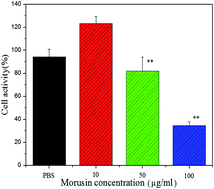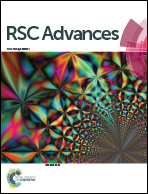Anti-tumor effect of morusin from the branch bark of cultivated mulberry in Bel-7402 cells via the MAPK pathway
Abstract
In this experiment, the morusin separated from the branch bark of cultivated mulberry, an edible medicinal plant, is used to study the inhibition of morusin in the human hepatocellular carcinoma cell line Bel-7402. The control and morusin-treated groups were used to study the effects of morusin on cell proliferation, apoptosis, antioxidant level and expression of tumor-associated genes. The results indicated that Bel-7402 cell activities were inhibited significantly after treatment with 50 μg mL−1 and 100 μg mL−1 morusin for 24 h, exhibiting a significant difference compared with the control group. Additionally, the symptoms of apoptotic cells, such as cell shrinkage and the reduced number of cells, were observed using an inverted microscope. Flow cytometry analysis indicated that the apoptotic rates of the tumor cells were 19.86%, 68.20% and 81.00%, respectively, after treatment with different concentrations of morusin for 24 h, and the mitochondrial membrane potentials were also decreased with the increase in morusin concentration. In addition, morusin can also induce the increase in antioxidant activity of the cells. It was also demonstrated that morusin can both downregulate the expression of NF-κB and upregulate caspase-3 and caspase-9. Western blotting results indicated that morusin can increase the expression of P-ERK1/2 and P-JNK to induce cell apoptosis through the MAPK pathway. Furthermore, morusin can induce the upregulation of the expression of Beclin-1, P53 and the downregulation of NF-κBp65. Therefore, the anti-tumor effect of morusin can induce the apoptosis of human hepatoma Bel-7402 cells via the mitochondrial and MAPK pathways.


 Please wait while we load your content...
Please wait while we load your content...